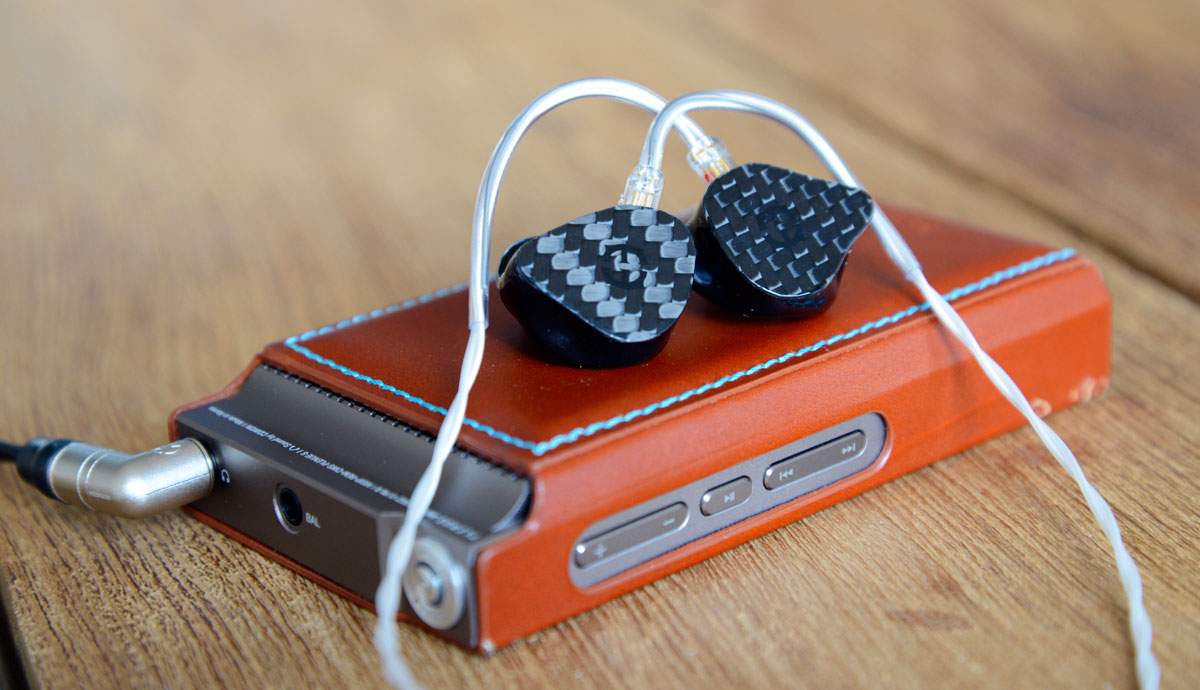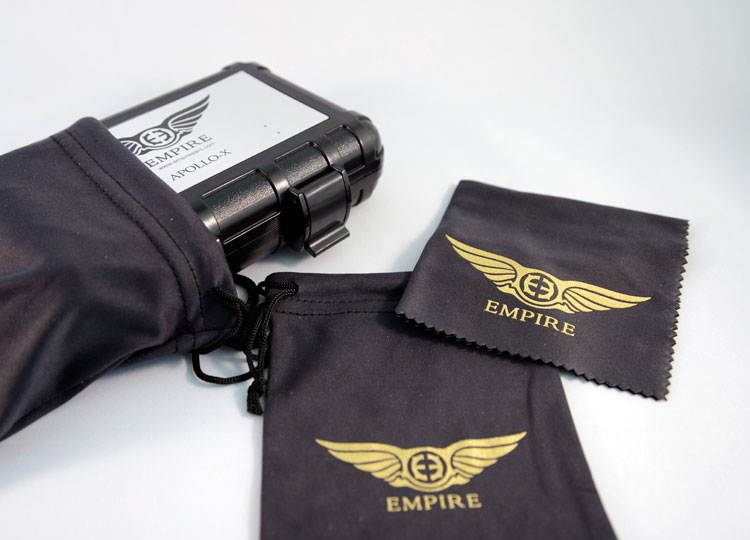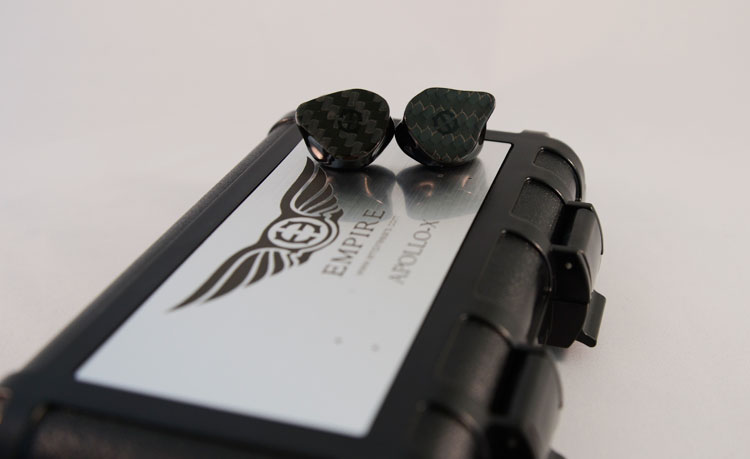The Empire Ears Apollo is a 10 Balanced armature driver custom monitor from Empire Ears. Read why nic thinks this CIEM has a very unique sound.
Disclaimer: The Empire Ears Apollo was sent to us in exchange for our honest opinion in this review. Many thanks to Empire Ears for giving us this opportunity.
You can read about previous Empire Ears products reviewed on Headfonics here.
Note, this review follows our new scoring guidelines for 2020 which you can read up on here.
EarWerkz recently made a fresh restart as Empire Ears. Fueled by ambition, Empire Ears proudly released a mission statement to raise the bar in quality and customer service – both for themselves and the industry.
Anyone that has dealt with Jack, can attest to the effort he puts in upholding that commitment. Empire Ears responds lightning quick, and will gladly help to come up with a personal design that goes beyond the listed options. In addition, they strive for a lead time of 2 weeks – significantly below the industry standard of 4-6 weeks.
EarWerkes originally made headway with models like the Supra and Legend, but still chose to design a completely new product line of iems from the ground up. With names inspired by Greek mythology, they initially presented Apollo as their highest offering.
Apollo, the god of music – a more than worthy name for a flagship. We’re all in it for the music, and what power lies beyond a god! With a configuration of 10 BA drivers, Apollo seemed like a logical choice for a top of the line offering, mirroring flagships from competitors in the same price range.
It’s marketed as Empire Ears’ take on a studio reference monitor, designed with a neutral signature and quality soundstage in mind. But unfortunately for dear Apollo, it only had the brief honor of holding the status of ‘flagship’.
A couple of weeks after its release, Empire Ears announced their true flagship: mighty Zeus, the god of the gods, stealing Apollo’s thunder (pun intended) with an industry first 14 BA drivers. But Apollo can still hold its own, and with a relatively more neutral tuning, it will appeal to a different audience than Zeus – not to mention saving a bit of spare cash.
Accessories
The Empire Ears packaging breathes an air of class and refinement, mirroring the standard of quality they’re aiming to achieve with their lineup. The matte black box folds back and contains a fairly large S3 carrying case which can be customized with your name.
In addition, there’s a small and large microfiber pouch to protect the case or just Apollo, as well as a cleaning cloth – all imprinted with the gold Empire Ears emblem and made from quality materials.
A custom will always come with little more than a cleaning tool, although some companies make an attempt by adding a plug or frequency chart. But there simply aren’t as many options as with universals, due to the lack of tips etc. It’s nice that Empire Ears makes the attempt with the extra pouches. I personally don’t care a great deal about packaging and accessories, but it’s hard to look past the thought and detail Empire Ears has put in the design – a very fulfilling unboxing experience.
Build
Empire Ears managed to keep Zeus with its 14 drivers well within proportion; despite its driver count, it still has a very average size for a TOTL.
The same holds for Apollo; while having 10 BA drivers, it’s not particularly large and doesn’t protrude out of the ears. I can even lie on one side if I choose so (although I don’t really feel comfortable doing so considering its value). The Solar, S-EM9, W500 AHmorph, and of course JH Siren series – all considerably larger. For the design, I went with translucent black, with matching black carbon.
The rapid emergence of new companies has stimulated competition, and the need to differentiate themselves has brought rise to all kinds of new customization options as abalone and pearl. So admittedly, carbon has lost a bit of its touch, being one of the first options for ciems.
But Empire Ears has managed to bring their carbon offering with a new twist; the rows of carbon scales shift color in the light, alternating between gray and black. There’s also a certain depth in the image.
Twisting the faceplate in the light has a mesmerizing, psychedelic effect, just watching the pattern change color. It’s reminiscent of those silver trading cards, with action figures that move in the reflection. It might be ‘just’ carbon, it’s become one of my favorite designs. Impossible to capture on pictures though.
Fit & Isolation
Empire Ears has publicly committed to upholding a high standard when it comes to finishing, and both my Apollo and Zeus can attest to that – there are no imperfections, and are very smooth all over. Insertion is easy, the nozzle has an average depth; neither shallow nor deep. I rate my Empire Ears ciems as the most comfortable I have, while still minimizing ambient sound to a minimum.
Cable
Both Zeus and Apollo are delivered with the BTG Starlight silver-plated copper cable. The 4-braided white cable is a nice accessory, especially considering most manufacturers still use factory-made generic 3-wire cables.
The finish of the cable is a bit simple, using a plastic slider and finish around the plug. My only complaint is the right angle 3.5mm plug. I’m sure a ton of people will prefer the right angle for some reason – I just can’t think of any. After the right hook, the cable immediately makes another 90 degrees turn when exiting my dap, putting a strain on the cable.
But again, I guess for other people it will be optimal. I tested the cable with other ciems to get a feel for its sound quality, and I do feel it is an improvement; cheaper generic cables generally have a bit less mid-bass control, giving a slight veil over the midrange. I’m pleased with the resolution and tonality of the BTG and feel it strikes a good balance between warmth and clarity.
Sound Impressions
Tonality
Apollo has a neutral signature, its signature is composed of a balanced presentation of the frequencies: bass is punchy without being intruding or clouding the midrange, its midrange has good size and average note thickness, while treble is clear and detailed – without being bright or sharp.
The general tonality is very accessible and easy to like, there isn’t something there that will specifically displease any type of listener. The background is very clear, and overall transparency is good. It performs well with a wide variety of instruments, as well as electronic music.
Bass
Apollo’s sub-bass has good extension and hits with good depth in the presentation. The mid-bass comes close to neutral, without being lean on impact. Its tone is slightly warm and has a relatively quick decay; its speed is fast and accurate.
It has a nice texture for a BA driver, but is less resolving than Zeus for instance, especially in the upper bass area – something like a bass saxophone has less prominence and definition in an ensemble.
The mid-bass is fairly clean and almost doesn’t give any warmth to the presentation – Apollo’s background sounds very clear. The sub- and mid-bass are very well balanced in quantity, and overall Apollo’s bass is punchy.
When amped, Apollo’s bass doesn’t sacrifice its control for quantity. I can see it is satisfying for both those that enjoy clean bass that doesn’t interfere with the mid-range, as well as those that prefer a bit extra rumble.
Mids
Apollo’s background is fairly clear and neutral, but the midrange has some inherent warmth that gives it a pleasant tonality. The lower midrange has a good presence, giving size and fullness to the midrange, without being too prominent.
The center midrange is a bit more forward, and while not to the extent of Zeus, Apollo still presents vocals with good depth and density – sound being produced from deep within the throat. But the overall vocal presentation is still more neutral than either forward or laidback (but then again, closer to forward than laidback).
The same holds for the upper midrange; vocals have good detail and emotional articulation, and although its ability here is above average I wouldn’t consider it a truly vocal specialist as a mid-centric iem as Zeus or the S-EM6.
Overall the midrange sounds very balanced and fine-tuned in its combination with the bass and treble. Both male and female vocals sound good, although I give the edge to female vocals; for male vocals specifically, I would go with Zeus due to the relatively more forward center mids.
Apollo’s midrange has good size without being thin or thick, is neither forward or laidback, and vocals are neither particularly dense nor hollow; you’ve probably guessed where this is heading – the keyword here is ‘neutral’. It’s tone, size, and warmth – all within throwing distance of neutral.
Treble
Apollo’s treble has a clear tone, with refinement in the style of the Empire Ears’ house sound. It sounds technically proficient, with a general focus on a non-piercing or fatiguing sound. A slight lift in the lower treble gives it its oh so airy soundstage, with lots of space for instruments to breathe.
The mid to high treble regions are slightly attenuated, giving it its smooth sound. I wouldn’t call it a sparkly monitor, although treble isn’t laidback either and has good detail. Apollo sounds fairly transparent and portrays acoustic and string instruments well.
While the treble is detailed, it lacks a bit of extension in the higher treble, which affects the midrange resolution; the top end of instruments can lack a bit of definition at times. Treble decay is quick, and the overall speed is excellent.
Soundstage
Apollo has a classic wide soundstage, with its width exceeding its height by a significant margin. There is good depth to the soundstage, and the overall space can be considered large, and quite three-dimensional.
In sheer size, the Apollo impresses and will be a delight for soundstage nuts. Instruments and tones have good proportions on the stage, and instrument separation is simply outstanding; there’s ample space for instruments to breathe, and its airiness is among the best I’ve heard.
The presentation on the stage is neither forward nor distant; instruments are spread out in good dimensions on both the depth and width of the stage. The wide soundstage does appear to have its effect on the imaging, as instruments can appear a bit diffuse sometimes, lacking a bit of pinpoint precision.
So while instruments are very easily differentiated and separation is simply outstanding, the imaging could be a bit more precise, although this applies more to the midrange than treble.
Select comparisons
EarSonics S-EM9
EarSonics’ flagship is equally tuned to approximate a neutral signature, and shares a similar overall clear and airy sound to Apollo, although its signature can be considered more U-shaped. Both share punchy bass with a good balance between the sub- and midbass, and no mid-bass leak to the midrange.
As such, they both have a clear background, void from warmth. Apollo has a slightly fuller midrange, and better ability to create both thin and thick notes; the S-EM9’ notes are on average thinner. Apollo’s midrange also has a bit more inherent warmth and slightly more prominent center mids.
As such, male vocals have better depth and size with Apollo, although the differences even out with female vocals. The S-EM9 on the other hand has the edge when it comes to treble; there’s a slight lift in the lower treble, and the S-EM9 can be considered very slightly U-shaped compared to the flatter Apollo.
The S-EM9 has a bit more sparkle, but overall differences aren’t that big. While transparency is about similar, the S-EM9’s treble gets the edge in extension.
Apollo is a fuller-sounding unit; with the S-EM9, vocals and electric guitars sound a bit thinner in comparison. But due to better treble extension, the S-EM9 has slightly better resolution; edging the Apollo out in midrange definition and detail. But overall, their tonality is more similar than different.
The soundstage is where they depart: both are very airy, but Apollo’s is noticeably wider and deeper. But there’s a clear tradeoff here – for fans of sheer size the Apollo will be the easy choice; the S-EM9’s on the other hand might be more intimate, there is more precision within the stage.
Rhapsodio Solar
Rhapsodio’s balanced armature flagship also sports a 10 BA driver design; but due to the choice of bigger midrange drivers, the Solar is noticeably larger in size. In contrast to Apollo, the Solar drifts far from neutral; it’s enhanced mid-bass gives size and warmth to the presentation.
Apollo’s bass is cleaner, with slightly better sub-bass extension. The enhanced mid-bass of the Solar gives it a powerful punch when called upon, although it can interfere more with the other frequencies; some might find it too overpowering.
The Solar’s full lower midrange gives male vocals depth and size, although Apollo’s relatively more forward center mids gives them slightly better density and clarity. Both have very airy treble, with a similar quantity in sparkle and speed – but the Solar’s has a warmer tone, compared to the clearer sounding Apollo.
Both have a wide and airy soundstage, but due to Apollo’s cleaner mid-bass presentation, Apollo has an airier sound; Apollo’s stage is also deeper. In accordance with its mid-bass, the Solar has thicker notes, while Apollo has more flexibility in average thickness.
The Solar’s thicker notes also take more space in the stage, contributing to the wide feel of Apollo’s stage. Compared to the Solar’s warmer mid-bass presentation, Apollo’s cleaner stage aids in separation; the Solar, in turn, has more precise imaging, one of the Solar’s outstanding traits.
Empire Ears Zeus
Designed on the same table, Apollo and Zeus undeniably share similarities, while having their own differences in signature and ability. Zeus’ bass has slightly more impact, and is overall more resolving, bringing out extra details in bass lines Apollo might miss. Zeus’ midrange was never intended to be neutral; its forward presentation is stimulating, powerful, and highly detailed.
The combination of the more prominent lower and center mids gives Zeus the edge in vocals – they sound powerful and clear, with greater depth and emotional articulation. Apollo’s midrange has a more neutral tuning; while still being slightly forward, it’s more in between laidback and forward compared to Zeus.
But due to Zeus’ relatively forward midrange, Apollo finds more balance between the midrange and treble. Both share a refined treble tuning, with a slight dip in the upper treble for a smooth sound. But Apollo’s mid-treble tuning gives it an airier sound, with just a bit more sparkle.
Due to Zeus’ mid-centric signature, it isn’t particularly airy, or does it have a very wide soundstage. Again, here they depart: Apollo’s soundstage is noticeably wider, compared to the relatively narrower but taller Zeus.
While both have good depth to the soundstage, Zeus impresses with its layering. But Zeus’ treble has the better extension and when it comes to technical ability, is a step ahead of Apollo. Transparency, resolution, and imaging – here, Zeus is in a class of its own.
Matchability
Due to Apollo’s relatively low impedance, it can be easily driven to volume by any source. That said, it will scale up nicely with a good quality source. Especially key features as its soundstage dimensions, resolution, and imaging tend to improve with better sources.
iPod Nano
With an iPod nano, for instance, a sacrifice is made of bass depth, impact, and texture. Apollo loses two of its key features, its clarity, and soundstage. Instead, the atmosphere is warm, and the soundstage suffers noticeably in width and depth – the overall space is severely reduced.
In accordance with the reduced mid-bass, the lower midrange is distant; vocals lack depth and size. In turn, the upper midrange is relatively more pronounced. The treble on the other hand becomes splashy and uncontrolled. In case this isn’t clear yet – this is not a combination I can recommend with a good conscience.
HTC M8
The M8 has a more musical presentation but feels generally restrained – like it’s holding back. There is good coherency on the stage, although the overall space is still a great deal smaller than a quality player.
The bass is still low in rumble, while the upper midrange is relatively more enhanced putting more emphasis on vocal articulation from the mouth rather than the throat and chest. Treble is more in line with the overall presentation but comes across as a bit dull. In case of say a battery-related emergency, I might be able to listen to this for a while
Hifiman 901S
When listening with the 901S, Apollo’s bass is fast, tight and clean; the relatively neutral bass gives Apollo a very clear background, almost void of all warmth. Apollo displays speed and quick decay, and an overall dynamic sound – the 901S’ specialty.
Apollo sounds very balanced between the lower and upper midrange, with a nice shimmer in the upper frequencies, though overall Apollo wouldn’t classify as an overly sparkly monitor – it simply isn’t in the intention of the design.
Vocals sound clear with a pronounced articulation, although there is a slight tendency for sibilance in some occasions. The pairing is nice; Apollo shines in its neutrality, with a clear background that aids in separation and detail retrieval.
Cowon Plenue S
The Plenue S is slightly warm over neutral, and Apollo’s signature tilts a bit towards mid-centric although it remains close to neutral. The mid-bass is slightly more pronounced, allowing the Apollo to create thicker notes compared to the leaner 901S.
Since the Plenue S’ background is blacker than the 901S, Apollo’s sound is darker and slightly less transparent; but the Plenue S gets the upper hand in resolution. Instruments have better definition, but set against the dark background detail presentation is still less obvious and upfront than with the crystal clear 901S.
The technical differences in resolution and transparency are slight though. But Apollo feels at home connected to the Plenue S: its stage is at the widest, with instruments fanning out on a deep and wide flat plane. And that’s just single-ended.
When Apollo is connected with a balanced silver litz cable, the stage gains in overall size, precision, and resolution; a finishing touch that lifts it to a higher level. If you happen to have a Plenue S and a balanced silver litz cable lying around, I’d highly recommend trying this combination.
Our Verdict
Apollo is a unique earphone that impresses with macro presentation: its general tonality and soundstage dimensions. Versatility is its forte; its neutral signature doesn’t discriminate against genres, while its ability to recreate both thin and thick notes allows electric guitars and vocals to sound full while sounding thinner for acoustics and string instruments as well.
This basically means you can throw anything at Apollo and it will always sound good. I tried to wear it down with rock, vocals, pop, EDM & hip hop – I even went out of my way with some classical and jazz, but Apollo demonstrated resilience and perseverance and held its stance. I find the term ‘all-round’ is easily (mis)used; even when vocals lack depth or treble is piercingly sharp.
Brace yourself, here it comes – I find Apollo to be very all-round; one of, if not the most, all-around within my collection. That being said, I personally use it most for female vocals and electronic music (specifically darker minimal techno or electro if that is of interest). But I don’t feel the need to take a second iem with me when I’m out, just in case I have an emergency need for a completely different type of music (like I usually do). Yes, I’m particular that way.
Staging King
Its unique soundstage impresses with size and airiness, but comes with a side note; the diffusion of instruments on the wide stage can affect its definition and focus. This is where Zeus demonstrates who is the one true ruler of Olympus. Imaging, resolution, and layering – that’s where the $500 difference comes into play.
On the other hand, this will probably be more noticeable for critical listeners, than the casual listener putting on some tunes to kickback. Zeus is forward and stimulating in its presentation, the bold leader that goes upfront. Its strong personality differentiates it from the herd – but its mid-centric tuning also makes it a bit more of a specialist.
Apollo’s neutral tuning makes it more all-round, and earns it its place alongside Zeus; there simply aren’t any constraints on which genres it can play. They’re both is unmistakably from the same stable: both share a clear background, excellent instrument separation, and refined treble. But their signatures vary and determine their applicability.
Apollo differentiates itself with its versatile signature and vast soundstage and will appeal to its own crowd by doing so.
Technical Specifications
- Driver configuration: 10 Balanced Armature drivers (2 low, 4 mid, 4 high)
- Design: 5-way, 4 point passive crossover, 3 sound bores
- Input sensitivity: 119 db @ 1mW
- Frequence response: 20 Hz – 20 kHz
- Impedance: 17 ohms @ 1 kHz
- Noise Isolation: -28 db






